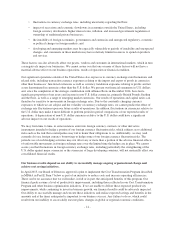Walgreens 2015 Annual Report Download - page 28
Download and view the complete annual report
Please find page 28 of the 2015 Walgreens annual report below. You can navigate through the pages in the report by either clicking on the pages listed below, or by using the keyword search tool below to find specific information within the annual report.Our quarterly results may fluctuate significantly.
Our operating results have historically varied on a quarterly basis and may continue to fluctuate significantly in
the future. Factors that may affect our quarterly operating results, some of which are beyond the control of
management, include, but are not limited to, seasonality; the timing of the introduction of new generic and brand
name prescription drugs; inflation, including with respect to generic drug procurement costs; the timing and
severity of the cough, cold and flu season; changes in payer reimbursement rates and terms; fluctuations in
inventory, energy, transportation, labor, healthcare and other costs; significant acquisitions, dispositions, joint
ventures and other strategic initiatives; asset impairments; the relative magnitude of our LIFO provision in any
particular quarter; fluctuations in the value of our warrants to acquire AmerisourceBergen common stock; foreign
currency fluctuations; prolonged severe weather in key markets; and many of the other risk factors discussed
herein. Accordingly, we believe that quarter-to-quarter comparisons of our operating results are not necessarily
meaningful and investors should not rely on the results of any particular quarter as an indication of our future
performance.
Our businesses are seasonal in nature, and adverse events during the holiday and cough, cold and flu
seasons could adversely impact our operating results.
Our businesses are seasonal in nature, with the second fiscal quarter (December, January and February)
typically generating a higher proportion of retail sales and earnings than other fiscal quarters. We purchase
significant amounts of seasonal inventory in anticipation of the holiday season. Adverse events, such as
deteriorating economic conditions, higher unemployment, higher gas prices, public transportation disruptions,
or unanticipated adverse weather, could result in lower-than-planned sales during key selling seasons. For
example, frequent or unusually heavy snowfall, ice storms, rainstorms, windstorms or other extreme weather
conditions over a prolonged period could make it difficult for our customers to travel to our stores and
increase our snow removal and other costs. This could lead to lower sales or to unanticipated markdowns,
negatively impacting our financial condition and results of operations. In addition, both prescription and non-
prescription drug sales are affected by the timing and severity of the cough, cold and flu season, which can
vary considerably from year to year.
We could be adversely impacted by changes in accounting standards and subjective assumptions, estimates
and judgments by management related to complex accounting matters.
Generally accepted accounting principles and related accounting pronouncements, implementation guidelines
and interpretations with regard to a wide range of matters that are relevant to our businesses, including, but not
limited to, revenue recognition, asset impairment, impairment of goodwill and other intangible assets,
inventories, vendor rebates and other vendor consideration, lease obligations, self-insurance liabilities, tax
matters, unclaimed property laws and litigation and other contingent liabilities are highly complex and involve
many subjective assumptions, estimates and judgments. Changes in these rules or their interpretation or changes
in underlying assumptions, estimates or judgments could significantly change our reported or expected financial
performance or financial condition. For example, changes in accounting standards and the application of existing
accounting standards particularly related to the measurement of fair value as compared to carrying value for the
Company’s reporting units, including goodwill, intangible assets and investments in equity interests, including
investments held by our equity method investees, may have an adverse effect on the Company’s financial
condition and results of operations. Factors that could lead to impairment of goodwill and intangible assets
include significant adverse changes in the business climate and declines in the financial condition of a reporting
unit. Factors that could lead to impairment of investments in equity interests of the companies in which we
invested or the investments held by those companies include a prolonged period of decline in their operating
performance or adverse changes in the economic, regulatory and legal environments of the countries they operate
in. New accounting guidance also may require systems and other changes that could increase our operating costs
and/or change our financial statements. For example, implementing future accounting guidance related to leases,
revenue and other areas impacted by the current convergence project between the Financial Accounting
-24-
























